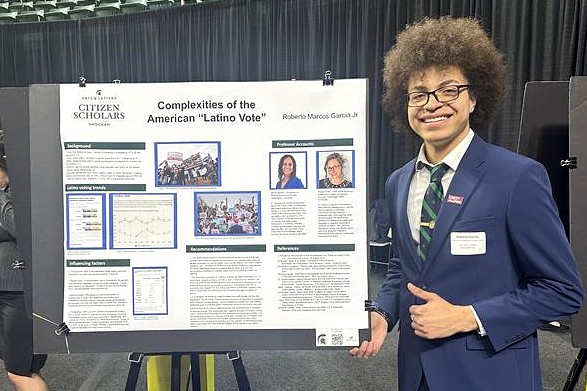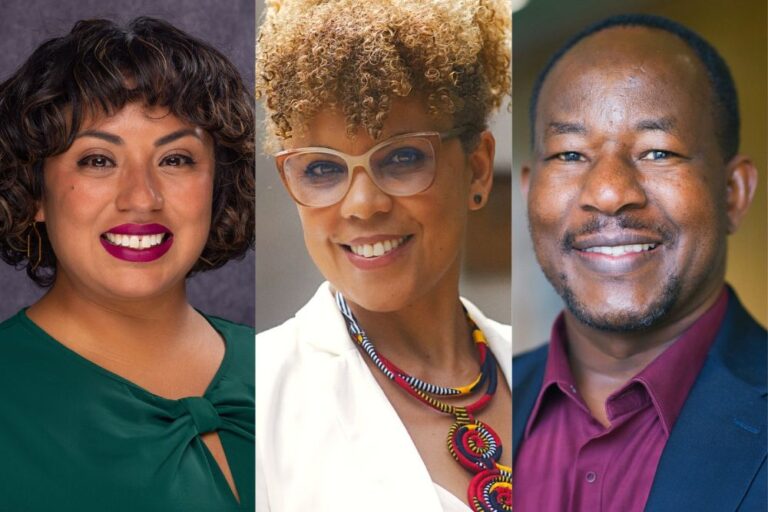Nine MSU students whose primary majors are in the College of Art & Letters received first-place awards for their research and creative scholarship presented at Michigan State University’s 27th Annual University Undergraduate Research and Arts Forum (UURAF).
The 2025 UURAF, held both in person at the Breslin Student Events Center and online on April 11, consisted of more than 900 presentations in 37 different subject areas made by more than 1,100 MSU students who were mentored by more than 700 faculty, staff, post-doctoral fellows, graduate students, and government/industry partners.

Held each spring, UURAF provides an opportunity for MSU undergraduate students to share their scholarship and creative activity with the MSU community. Student participants gain experience presenting their research and answering questions about their work while receiving constructive feedback from judges.
The UURAF Awards Ceremony took place April 21 at the Kellogg Hotel and Conference Center when the first-place awards of $100 each were presented.
First-place award recipients are now eligible to submit their work for consideration for one of the two grand prize awards of $500 each. One grand prize will be awarded in the arts, humanities, and social sciences related categories and the other in the science, engineering, and mathematics related categories. The grand prize award winners will be announced in mid-June.
The following are the nine MSU students with primary majors in the College of Art & Letters who received first-place awards at UURAF:
- Ocean Angelo, junior Linguistics major
- Hayley Asai, junior Graphic Design major
- Omni Brewer, junior Experience Architecture major
- Ezekiel Brown, sophomore Linguistics major
- Roberto Garcia, sophomore English major
- Alex Guo, junior Humanities-Prelaw major
- Anthony Monteleone, senior Theatre major
- Phoenix Poole, senior Studio Art major
- Elliot Snyder, junior Experience Architecture major
Ocean Angelo
Angelo earned first-place honors in the Linguistics, Languages, and Speech category for his poster presentation, titled “Testing Gender and Animacy with Artificial Language,” and was mentored by Cristina Schmitt, Associate Professor in the Department of Linguistics, Languages, and Cultures.
Abstract:
Pronoun systems vary in terms of what kinds of features they encode. In English, for example, pronouns carry person, number, and gender features. One way to study whether some of these features are more basic than others is to examine these properties in a controlled environment by creating an artificial language that mimics these features. This study uses an artificial language to investigate how learners perform in a task where they must implicitly learn a pronoun system.
Inspired by contact between Paraguayan and Argentine Spanish, the artificial language includes a determiner system that agrees with gender features on nouns (±Masc) and a pronoun system which agrees with either animacy (±Anim) or gender (±Masc) of that noun that it refers to. The goal is to determine whether learners are more sensitive to animacy or gender when learning the artificial system and whether they can extend that system to new noun stimuli.
Results from this study will contribute to the understanding of how learners attend to morphosyntactic features in language learning. By testing learner sensitivity to animacy and gender features across lexical categories, this work provides insight into which grammatical features are most informative or more basic. We predict the results will reveal that either a) participants model explicit grammatical cues related to gender or b) rely on cognitively salient categories like animacy, which is not explicitly encoded on determiners.
Hayley Asai
Asai earned first-place honors in the Visual and Performing Arts category for her poster presentation, titled “Exploring the Effectiveness of Signs and Landmarks in Wayfinding,” and was mentored by Rebecca Tegtmeyer, Associate Professor in the Department of Art, Art History, and Design.
Abstract:
In wayfinding contexts, signs and landmarks are crucial for the navigation of any given physical space. Those moving through a space will use the visual language on signs and the reference points of landmarks to navigate and direct themselves to an end goal.
Visual design aspects evident in elements such as typeface choice, style, use of applied colors, and additional imagery are critical in informing a user’s information-processing. This concept is necessary in the creation of a wayfinding system that accurately guides the user through a space.

With in-depth inquiries into an existing system, we are able to gain insights surrounding the current obstacles and challenges that could be improved with attention to basic design decisions. This research project concerns the effectiveness of wayfinding systems, specifically the utility of signs and landmarks.
The Michigan State University Main Library served as the context for investigation. The overarching research questions guiding this project are: In what ways do the present signs and landmarks succeed or fail at guiding library visitors in their end goals? What challenges and obstacles are evident in their navigation? How can design better intervene in providing a more positive navigating experience for library visitors?
The project is in the first phase of investigation and is a synthesis of documentation, observations, interviews, and consultation of existing literature regarding wayfinding factors. This work has resulted in findings that will inform the next phase of identifying interventions and prototyping possible outcomes.
Omni Brewer
Brewer earned first-place honors in the Cell Biology, Genetics, and Genomics category for her poster presentation, titled “Investigation into the Effectiveness of Maximum-Likelihood Methods for Developing Phylogenetic Trees,” and was mentored by Kevin Liu, Associate Professor in the College of Engineering.
Abstract:
Understanding the progress of evolution across time is an incredibly challenging task that researchers have been struggling with for decades. Many different software solutions have been developed to overcome different issues with phylogenetic tree reconstruction. However, due to the computational intensity of this problem sometimes heuristics must be used to produce a tree in a reasonable amount of time.
In this experiment, simulations were used to develop original trees to test one of these heuristic methods. The estimated tree from the heuristic software and original tree were compared using statistical methods. This gives a quantitative value for the accuracy of the heuristic method.
Ezekiel Brown
Brown earned first-place honors in the Linguistics, Languages, and Speech category for his poster presentation, titled “Verb Agreement with Non-DP Subjects,” and was mentored by Alan Munn, Associate Professor in the Department of Linguistics, Languages, and Cultures, and Louis Konkoly, Graduate student in the Department of Linguistics, Languages, and Cultures.
Abstract:
In English, verbs must agree in plurality with their subjects. For example, ‘The dog is running’ is grammatical, while ‘The dogs is running’ is not. Conjoined subjects like ‘the dog and the cat’ behave just like plurals: we can say ‘The dog and the cat are running’ despite the fact that neither ‘dog’ nor ‘cat’ are plural by themselves. By conjoining them, the whole phrase is semantically plural. A similar pattern occurs with conjoined prepositional phrase (PP) subjects: ‘Under the bed and in the closet are good places to hide’. However, singular is also possible with these sentences: ‘On the couch and by the window is a comfy place to sit’.
Previous literature attributed this kind of singular/plural alternation to the semantics of the conjoined phrases. Conjoined PPs interpreted as a single location trigger singular agreement while those interpreted as multiple trigger plural. However, we argue that the verb doesn’t agree with the PPs at all. Instead, we analyze it as agreeing “downward” with ‘places’/’spot’. Downward agreement, as in sentences like ‘There is a dog and a cat in the room’, doesn’t respect semantic plurality.
We predict the PPs’ semantic plurality to have minimal impact on agreement. To test our hypothesis, we ask participants to rate the acceptability sentences they read. By presenting them with mismatches between the PPs’ semantic plurality and the plurality of the place denoted by the conjoined PP, we can determine which analysis best captures the speakers’ verb agreement patterns.
Roberto Garcia
Garcia earned first-place honors in the Diversity and Interdisciplinary Studies category for his poster presentation, titled “Complexities of the American ‘Latino Vote,” and was mentored by Michael Ristich, Academic Specialist in the Department of Writing, Rhetoric, and Cultures.
Abstract:
During every major election cycle in America, conversations about the “Latino vote” become ever more prevalent in political analysis and scholarships. As more generations of Latinos are born in or come to America, there are more Latine perspectives to consider.

This project explores the effect of disinformation, identity, and values and how combining these factors has led Latinos from the political left to the political right. This presentation aims to provide analysts and policymakers with a more nuanced understanding of factors at play when Latinos make their way to the ballot box.
This name designation, however, fails to encapsulate the diversity of perspectives and experiences that make up this “Latino vote,” which candidates work so strongly to convince. As Latinos in America vary in their perceptions, their views on how law and policy will affect them and their loved ones similarly change.
Alex Guo
Guo earned first-place honors in the Humanities category for their poster presentation, titled “Investigating Prosecutorial Misconduct: Examining Systemic Failures and Accountability Measures,” and was mentored by Michael Ristich, Academic Specialist in the Department of Writing, Rhetoric, and Cultures.
Abstract:
Prosecutorial misconduct undermines the integrity of the judicial system, leading to wrongful convictions, diminished public trust, and systemic inequities. This paper explores the various forms of prosecutorial misconduct, including withholding exculpatory evidence, coercing false testimony, and engaging in prejudicial courtroom behavior.

By analyzing court cases, statistical trends, and institutional barriers to accountability, this study highlights the structural deficiencies that enable prosecutorial misconduct to persist. Furthermore, it examines the effectiveness of current oversight mechanisms, such as judicial sanctions, bar disciplinary actions, and conviction integrity units.
This paper argues for stronger regulatory frameworks, increased transparency, and policy reforms to ensure prosecutorial accountability and safeguard defendants’ rights.
Anthony Monteleone
Monteleone earned first-place honors in the Diversity and Interdisciplinary Studies category for his poster presentation, titled “The Corey Marsh Theatre Project: Exploring Place-Based Art Integration in Local Conservation,” and was mentored by Emily Pomeranz, in the College of Agriculture and Natural Resources.
Abstract:
The use of art as a bridge between conservation and the public is well-studied, however research exploring the bi-directional impacts of science education and artistic creativity on artists, scientists, and audiences is limited.

Over the summer of 2024, a team of researchers facilitated the collaboration between scientists and artists in a series of five workshops in which both the artists and scientists shared their areas of expertise and the artists led artistic activities integrating these ideas into artistic outputs. The artists then took the lessons from these workshops to write, rehearse, and perform an original place-based play, titled “The Link,” at the Corey Marsh Ecological Research Center, a wetland restoration research site owned and operated by Michigan State University where “The Link” was produced.
A primary research objective from this work was to evaluate the impacts of this creative collaborative work on the attitudes of artists and scientists involved regarding art and its role in conservation, the power dynamics between artists and scientists, and participants’ interest in continued pursuit of art-science collaborations.
In the nature of this project, the poster was presented by two Michigan State University undergraduates: Ben Eiler, the lead undergraduate researcher on the project, and Anthony Monteleone, the director of “The Link.”
Through the poster, Eiler shared the findings associated with this project and Monteleone shared his experience as an artist working on this collaborative place-based play. The poster highlights the importance of forging new collaborations and the power of place-based art in conservation.
Phoenix Poole
Poole earned first-place honors in the Visual and Performing Arts category for their presentation, titled “The Prominence of Book Bans,” and was mentored by Lorelei d’Andriole, Assistant Professor in the Department of Art, Art History, and Design.
Abstract:
More and more often across the United States, books of all kinds are being banned from schools. For one reason or another, materials for learning are finding themselves censored. These books are no longer accessible to those who might benefit from the knowledge held within. It is not too dissimilar to the ultimate preservation of knowledge, keeping it so far locked away that only a select few can access it. In both cases, people who could use the information are kept separate from it for seemingly arbitrary reasons. The preserved books are still readable, even if they are only accessible by select individuals.

Poole argues that both book banning and extreme preservation are bad and examines the connections between different banned books, looking into where each individual book is banned. Poole choose 3-4 books of different subject matters and preserved them by growing different colored crystals over them. The books will be open to particularly striking or discussed pages and will be unclosable.
During this research, he expected to learn what kind of books get banned, why books get banned, and ways to best preserve books. This piece is a lot about the process over the final product. The crystals relate to nature, while the books relate to the made world. This piece fits into his portfolio by calling back to humanity.
Elliot Snyder
Snyder earned first-place honors in the Physical Sciences category for his poster presentation, titled “Image Segmentation in Patients with Left Ventricular Assist Devices,” and was mentored by College of Engineering Associate Professor Lik-Chuan Lee and Research Associate Sandra Hager.
Abstract:
The Framingham Heart Study (FHS) reported that the lifetime risk of heart failure (HF) increased from 19.0% to 23.7% between 1965 and 2014, indicating a rising prevalence in the future. Treatment methods for HF vary depending on its severity and may include inotrope-dependent medication, heart transplantation, or continuous-flow left ventricular assist devices (LVADs).
Patients with late-stage HF are commonly implanted with an LVAD, a mechanical pump that takes over the pumping function of the failing left ventricle (LV). HF patients with an LVAD show a high survival rate of 82.3% after one year, though this declines to 46.8% after four years. However, complications such as bleeding, infection, and right ventricular failure remain significant concerns.
This project utilizes computed tomography (CT) images acquired non-invasively to assess the patient’s cardiac anatomy. The next step involves image segmentation using ITK-SNAP, an interactive software application, to generate personalized cardiac models of the patient’s heart in both preoperative and postoperative states. The postoperative model includes LVAD segmentation. Expanding the cohort of personalized cardiac models may enable the prediction of critical clinical parameters that influence the success of LVAD implantation.
By Kim Popiolek


